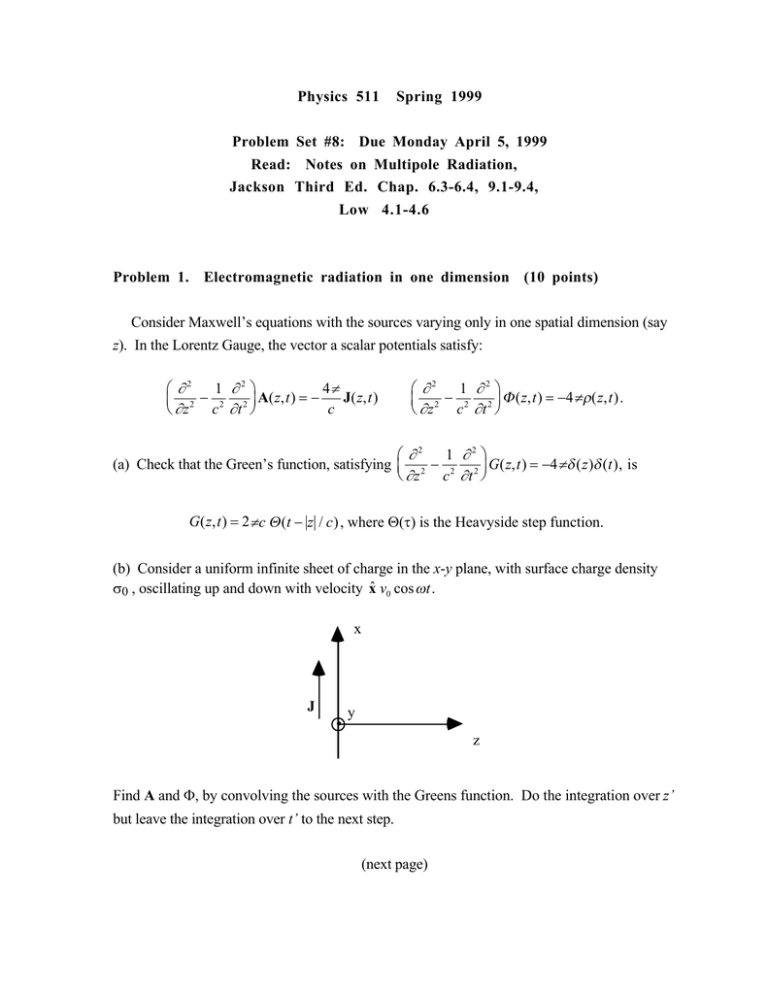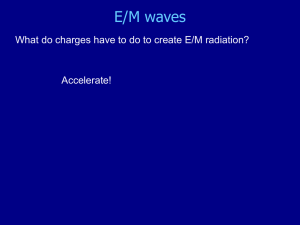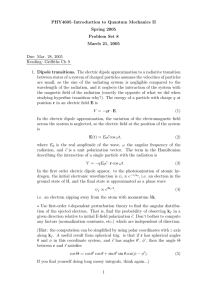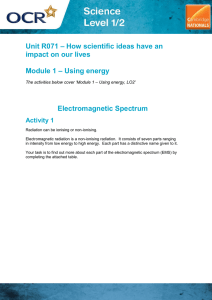Physics 511 Spring 1999 Problem Set #8: Due Monday April 5, 1999
advertisement

Physics 511 Spring 1999 Problem Set #8: Due Monday April 5, 1999 Read: Notes on Multipole Radiation, Jackson Third Ed. Chap. 6.3-6.4, 9.1-9.4, Low 4.1-4.6 Problem 1. Electromagnetic radiation in one dimension (10 points) Consider Maxwell’s equations with the sources varying only in one spatial dimension (say z). In the Lorentz Gauge, the vector a scalar potentials satisfy: ∂2 1 ∂2 4π J(z,t) 2 − 2 2 A(z,t) = − ∂z c c ∂t ∂2 1 ∂2 2 − 2 2 Φ (z,t) = −4 πρ (z,t). ∂z c ∂t ∂2 1 ∂2 (a) Check that the Green’s function, satisfying 2 − 2 2 G(z,t) = −4 πδ (z)δ (t), is ∂z c ∂t G(z,t) = 2 πc Θ (t − z / c) , where Θ(τ) is the Heavyside step function. (b) Consider a uniform infinite sheet of charge in the x-y plane, with surface charge density σ0 , oscillating up and down with velocity x̂ v0 cos ω t. x J • y z Find A and Φ, by convolving the sources with the Greens function. Do the integration over z’ but leave the integration over t’ to the next step. (next page) (c) Now calculate E(z,t) and B(z,t). Be careful to note that d z / dz = sign(z). Show that 2 πσ 0 v0 cos[ω (t−|z| /c)]x̂ + 2 πσ 0sign(z) ẑ, c 2 πσ 0 v0 cos[ω (t−|z| /c)]sign(z) ŷ B(z,t) = − c E(z,t) = − That is, in addition to the electrostatic field we have electromagnetic waves propagating to the left and right. Show that your solutions satisfy the expected boundary conditions at z=0. (d) Compare the rate of creation of electromagnetic energy per unit area to the flux density of energy being carried away by the electromagnetic waves. (Note: If you were shaking this sheet up and down, the electric field of the sheet will oppose you, and you will have to put energy in to keep the sheet moving at a constant amplitude. The electromagnetic force that opposes your effort at z=0 is the radiation reaction force. This is sometimes know as the “wave impedance” or “radiation resistance”) (e) In Problem Set #7, problem 2 we considered the reflection of an electromagnetic wave from a perfectly reflecting surface. We can understand this as the waves driving currents on the surface of the conductor which in turn re-radiate waves to the left and right. Show explicitly that the re-radiated field generates the reflected wave (with the proper amplitude) and exactly destructively interferes with the incident wave. Problem 2 Radiation by a rotating electric dipole (15 points) Consider an electric dipole rotating in the x-y plane y +q s/2 x ωt –q The motion of this dipole can be model by the superposition of two linearly oscillating dipole which are 90° out of phase with one another: p(t) = p0 cos(ω t) x̂ + p0 sin(ω t) ŷ, p0 ≡ qs . (a) An observer is located at position (r, θ , φ ), with respect to the origin at the center of the ring. If we write the electric field associated with the dipole radiation as E(x,t) = Re Ẽ(x)e −iωt , show that the complex amplitude in the radiation zone is, [ ] ( Ẽ(r, θ , φ ) = k 2 p0 cos θ θ̂ + iφ̂ ) ei(kr+ φ ) r What is the polarization of the wave at an arbitrary point? (b) As a check show that on the x, y, and z axes the real part of the electric fields are sin(ω t − kx) ŷ x cos(ω t − ky) x̂ On y-axis (i.e. θ=π/2, φ=π/2) E(x,t) = k 2 p0 y cos(ω t − kz)x̂ + sin(ω t − kz)ŷ On z-axis (i.e. θ=0, φ=0) E(x,t) = k 2 p0 z On x-axis (i.e. θ=π/2, φ=0) E(x,t) = k 2 p0 (Remember that the values of the spherical unit vectors depend on position. e. g. Along x-axis (i.e. θ=π/2, φ=0) θ̂ = ẑ , φ̂ = ŷ ) Please explain why these are what you expect. (c) Find the time-averaged rate at which electromagnetic energy, momentum, and angular momentum, are radiated per solid angle. Sketch the angular distribution of both the radiated power, and the z-component of the angular momentum. (d) Find the total time-averaged rate at with energy, momentum, and angular momentum are radiated to infinity. Comment on your result. Problem 3 Magnetic Dipole Radiation (10 points) Pulsars are thought to be rotating neutron stars, which have a strong magnetic moment, but which rotate about an axis different than the magnetic north pole (as does the earth) ω m ψ Given a neutron star with typical radius of 10 km, a rotational period of 10–3 s, a surface magnetic field of 108 Tesla, an a tilt of ψ=10 degrees. Calculate the energy radiated (as magnetic dipole radiation) per year and estimate the relative change per year (use the solar mass as an estimate of the star’s mass). How long will such a pulsar “live”? Problem 4: Radiation from the hydrogen atom (10 Points) (This is problem 9.4 from Jackson 2nd edition) Consider the hydrogen atom in a superposition of the ground state (1s) and the first exited state (2p, m=0), where m is so-called the “magnetic quantum number”. The effective charge density, associated with the electron motion relative to the nucleus, is given by product wave functions ( ρ (r, θ ,t) = −eψ 2* p,0 (x,t)ψ 1s (x,t) + c.c.= 2 Re −eψ 2* p,0 (x,t)ψ 1s (x,t) 4e −4 −3r / 2 a0 = Re a0 re Y00 Y10 (θ ) e −iωt 6 ) , where a0 = h 2 / me 2 is the Bohr radius and hω 0 = 3e 2 / 8a0 is the energy difference beetwen the two levels. (a) Evaluate all the radiation multipoles in the long wavelength limit. (b) In the electric dipole approximation, calculate the total time-average power radiated. Express your answer in units of α 4 (hω 0 ) c / a0 where α = e 2 / hc is the fine-structure constant. (c) Estimate the transition rate betewn energy levels as the classical power divided by the photon energy hω 0 . (d) If, instead of the semiclassical cahrge density used above, we described the 2p state by a circular Bohr orbit of radius 2a0 , with the electron moving at the angular velocity ω0, what would the power be? Express your answer in the same units as in (b) and evaluate the ratio of the two powers numerically. Please comment on your result.






